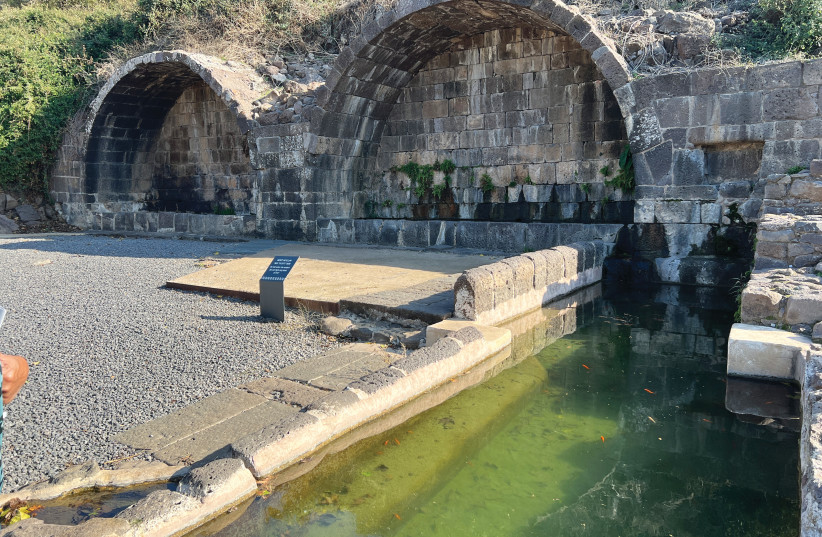Now that we are in the midst of winter, our natural tendency is to burrow deep inside our blankets – yet this is the ideal time of year to take a trip to the Golan Heights. Although we have not been inundated with rain so far, enough has fallen to fill the area’s streams, while the blossoming winter flora has covered the ground in a different sort of blanket – of green grass and colorful flowers.
As you drive up the winding roads of the southern Golan, you will see a plethora of natural wonders, as well as several tourist attractions. Here is a list of places that are definitely worth visiting in the winter months.
1. Ein Keshatot
One of the most fascinating national heritage sites in Israel is Ein Keshatot, located at the foot of Moshav Natur. At Ein Keshatot, visitors can walk around the site, enjoy the breathtaking cliff-top view toward the Samekh riverbed and Lake Kinneret, see the remains of the ancient Jewish village, walk by the water spring, and visit the impressive synagogue that dates back to the Talmudic period (sixth century), which has undergone careful conservation. The trail at Ein Keshatot, which is wheelchair accessible, begins at the impressive entrance hall of the nature site, which was carved into the mountain.
Upon entering, visitors are given a map of the site and can watch a five-minute film about the history of the site that even the kids will enjoy. The film explains how an ancient village existed on the site 1,500 years ago, and how archaeologists painstakingly excavated every part of the site so they could learn everything they could about its past, and prepare the ground for visitors.
For example, during the excavation and subsequent reconstruction of the synagogue, archaeologists numbered each stone they removed so they could reconstruct it perfectly once the excavations was completed.

After they’ve seen the film, visitors go outside to view the excavations. There are panels spread around the site that offer explanations, such as how a powerful earthquake in 749 CE destroyed the synagogue and the entire village.
Walking down the path, they reach a spring (note: swimming in it is forbidden), with lots of fish swimming around. The spring is located inside a rectangular structure with three arches, from which the site derives its name.
Next, is the synagogue. Originally two stories, only the first floor has been reconstructed. In view is the niche that served as the holy ark where the Torah scrolls were placed.
The tour around the site takes about an hour to complete. Those visiting with children might want to take part in a fun navigation game during which the kids will have to answer questions to solve a riddle.
Price: NIS 28 per person (from age five)
2. Moshav Avnei Eitan
People who grew up on a moshav or kibbutz remember all too well the steps involved in procuring milk. If your children have never seen a cow being milked, then visiting the robotics barn at Moshav Avnei Eitan in the southern Golan Heights is a great idea.
During the 75-minute tour of the advanced robotics barn, kids and adults can first watch a short video titled “From Hand-Milking to Unassisted Robot Arms,” and then observe the robots help the cows decide for themselves when it is time to milk. In this setting, where the old and new worlds converge, the robots move alongside the cows in a completely sterile environment.
Guests will also see calves feeding on a bottle, watch how butter is churned, and enjoy some milk chocolate.
Location: Plot #37, Avnei Eitan. Open Sunday-Friday
Price: NIS 40
Details: 050-406-0311
3. Bell Ofri Tourist Farm
Located in Moshav Kidmat Tsvi, the Bell Ofri Tourist Farm was created and is run by Tami and Babi, who offer gracious hospitality and delicious meals in their restaurant, which they constructed from recycled materials.
After their four children had grown up and left home (the couple has named parts of their farm after their kids and grandchildren), Tami and Babi began taking workshops that explore spirituality and mind-body connections. Babi enjoyed courses such as stained glass, goldsmithing, cheese- and wine-making. Tami chose to dive into Jewish philosophy.
On one of their ecology tours, you will see restored ancient agricultural techniques, such as a threshing floor, an olive press, a wine press and a wood-fired clay oven for cooking and baking.
Bell Ofri also takes in injured animals and rehabilitates them. Their herd of goats provides fresh milk that Babi uses to make their Noam line of cheeses, which can be purchased at their visitor’s center.
They also have a wine cellar stocked with bottles of their Ein Nashut wines, named after the ancient village that was located on the site. All the food served in their restaurant is prepared by Tami on site. Breakfast includes a variety of cheeses and wines produced by Babi, as well as jams and pastries made by Tami. Visits must be reserved in advance.
Details: 052-880-5026
4. The Gillis Restaurant
Not only does the Gillis family run a restaurant and a butcher shop, but they’ve also been raising cattle for 45 years. We’re not talking about just another great steakhouse but a multi-generational business.
Located in Moshav Nov, the farm, butcher shop, and restaurant were all built by Yossi who, over the years, has been joined by his children and grandchildren.
The restaurant is open to the general public only on Thursday evenings; the rest of the week is reserved for groups.
Diners are served an appetizer of hummus and beef, followed by the main course, with side dishes of red potatoes and fresh salads.
Price: Ranging from NIS 150 to NIS 320
Details: (04) 676-3555
Translated by Hannah Hochner.
